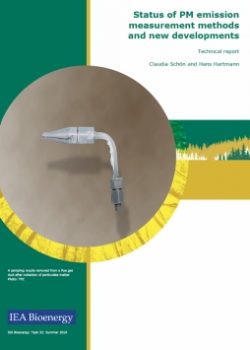Status of PM emission measurement methods and new developments
Background
Particulate matter emissions (PME) from biomass combustion have always been in the focus of air pollution control. Due to their small size (mostly below 1 µm aerodynamic diameter) they can easily pass through the nose and throat into the lungs. Additionally, many such PM-enriched flue gases also carry organic gaseous carbon species (OGC) which act as precursors for secondary organic aerosols (SOA). Via photo-oxidation under the influence of UV-radiation these organic species can also contribute to the total PM concentration in an atmosphere.
However, to evaluate the magnitude at which a biomass based PME source contributes to atmospheric pollution is not an easy task. Many different methods have historically been used to measure PME from the flue gas of residential appliances and boilers for biomass (mostly wood). Confusion has arisen in the market as different and conflicting results are quoted in literatu

re and test reports. Even within Europe, where common market rules should apply, several national measurement standards are living side by side, and compatibility of reported PME levels is not given. In a worldwide consideration such differences are even higher, and manufacturers cannot access new markets without providing additional test results based on the respective measurement standard applied in the region.
But even where there is an agreement about using a specific test standard, there is usually still quite some room for its interpretation. Knowledge about the impact of given variation concerning suitable measurement equipment, the materials used, or the operational settings during a test is quite low, or at least little attempt has yet been made to compile such knowledge as a basis for further specification of measurement rules. And beyond these difficulties there is one more challenge: Other than for measurements of gaseous emissions, PME measurements suffer from the fact that there is no system for calibration which could validate the full PM-sampling and measurement process under realistic conditions. Therefore, uncertainty about research data for PME is always relatively high.
Aim of this report
This report aims to stimulate an international approach towards one (or few) method(s) for determining particle emissions from biomass based combustion. Thereby, the focus is set only on the actual PM-measurement technique while disregarding the way how an appliance is operated during a test. This goal is approached by three key activities:
- to provide an overview on the diversity of existing measurement strategies in order to emphasize the need for a harmonized approach;
- to provide knowledge on the influence of method variations (e.g. equipment, test rig design, operational parameters, materials used, deposits, etc.) on measured PME results. Where possible, quantitative results from published and unpublished documents are cited and
- to present and to describe the recently developed EN-PME method which was suggested as common European measurement strategy. This is to raise discussion about its suitability for an international approach within and beyond European boundaries.
Download here: IEA Paper_PM_determination


